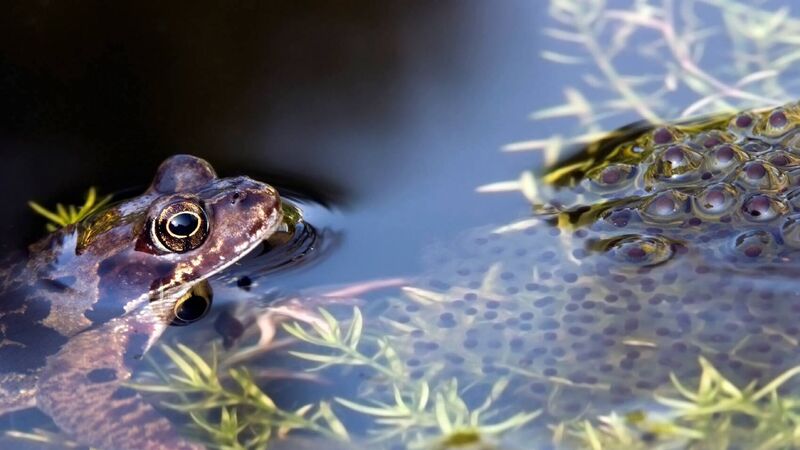Anja Murray: Frogs are gardeners' friends — encourage them with a pond in your garden

Brown frog and frogspawn
Ireland has an estimated 165 million frogs. That’s more than 20 frogs per hectare, making these little green creatures one of the most numerous vertebrates in Ireland.
Being a wet country, frogs are well suited to Irish habitats, with plenty of ponds, lake edges, bogs, wet ditches and other places where frogs can breed.
Frogs are amphibians, they generally live on land but are also adapted to breathe underwater, through their thin, delicate skin. But this thin skin also makes frogs vulnerable to drying out easily. For a frog, to dry out means to die, so they rarely linger in long in open areas or dry places. Instead, they spend their time hunting for insect prey in damp fields, open woodlands, wet bogs, fens and marshes, sheltered among clumps of moss and tall vegetation.
This is also why most of us seldom see frogs. Even when they are near, we are unlikely to notice them, as they can change the colour of their skin to match the palette of their environment in less than two hours. This helps them camouflage from the keen eyes of predators.
Frogspawn, however, is a familiar sight in spring. During February and March, adult frogs follow the very same routes their forbears followed for generations, through wet ditches, streamsides and damp fields, tracing their way back to the very same pond, bog pool, wet ditch or lakeshore where they began life.
For the frogspawn, it takes about two weeks for the black dot in the middle to grow into a tadpole. If the pond or ditch where the spawn is laid dries up in the meantime, none of the spawn will ever develop into a tadpole. But if April droughts don’t dry out the spawning place entirely, by May, ponds everywhere will be brimming with young frogs. Some will be tadpoles still, some have grown little hind legs, and others have already grown into tiny little froglets.
All these tadpoles and tiny baby frogs are eaten by dragonfly larvae, fish and other creatures, so very few of them will make it to maturity. Those that survive migrate in the summer months to fields, bogs and woods. They mainly feed on slugs and flies, making them a gardener’s friend. An abundance of little frogs means plenty of protein-rich food for many of our native birds and mammals. Otters eat a lot of frogs. Research suggest that one-fifth of an otter’s diet is made up purely of frogs. Herons too are fond of frogs. As excellent hunters, herons spot and catch frogs easily with their long dagger-like bill.
While frogs are always knowns to be an important component of Irish ecosystems, their native status in Ireland has been a matter of some dispute over the years. At the end of the last ice age, after the glaciers melted and the sea level rose rapidly, many plants and animals had not made it this far west by the time the sea level rose. Only those that made it to these shores without the helping hand of humans are considered native. It has been postulated that frogs never made it here by themselves but were introduced on purpose by the Normans. Others have suggested that frogs were introduced from Britain in the 17th century. But now, with the insights provided by genetic analysis, it has been discovered that there are two distinct lineages of frogs in Ireland. One does indeed come from Britain, likely brought in by settlers from the neighbouring island. The second is a distinct genetic grouping of frogs that have been here since the end of the last ice age. So frogs, it seems, are likely to be native here after all.
Globally, the decline of frogs and other amphibians has been cause for major concern. A stupendous one-third of all species across the globe are seriously threatened or already extinct.
Habitat loss has been a major cause, as is the case for declines in many birds and mammals too, although frogs and amphibians have also been impacted by a fungal disease which has decimated some populations.
The frog that we have in Ireland, Rana temporaria, has so far shown resilience to this disease, and is not classed as a threatened species here. This is despite extensive habitat loss over the past 50 years. Wetlands have been routinely drained away and urban areas have sprawled out. Farm ponds, once important as watering holes for livestock, have now been mostly filled in and replaced with piped water sources, or simply lost due to agricultural intensification. There are now half as many farm ponds in Ireland as there were 100 years ago.
Two landscape features have been helping frogs survive in the face of mounting threats. Drainage ditches often run alongside hedges and these can offer habitat for frogs through most of the year. Wildlife ponds are the other feature that seem to have been helping sustain frog populations in recent decades.
Most of us know from school days that frogs need ponds to breed in, and ponds are great for lots of other species too, from beautiful damselflies to thirsty birds. With Climate Change bringing on periods of drought both in spring and in summer, frog breeding grounds are more likely to dry out at some point. Damp ground is also needed for frogs to travel to and from their breeding grounds each spring, and these too are more vulnerable to long spells of dry weather.
These risks make it all the more pertinent for more of us to make a pond in the garden or on the farm. A well-designed pond will likely host breeding frogs before long. And remember that they need shelter from the sun and from predators, so leaving grass to grow, retaining banks and ditches, keeping stone walls and wet field corners are all helpful actions for frogs.
- Anja Murray is an ecologist, broadcaster, regular presenter on on RTÉ One and writes weekly on RTÉ Lyric FM.








